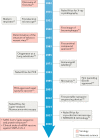A materials-science perspective on tackling COVID-19
- PMID: 33078077
- PMCID: PMC7556605
- DOI: 10.1038/s41578-020-00247-y
A materials-science perspective on tackling COVID-19
Abstract
The ongoing SARS-CoV-2 pandemic highlights the importance of materials science in providing tools and technologies for antiviral research and treatment development. In this Review, we discuss previous efforts in materials science in developing imaging systems and microfluidic devices for the in-depth and real-time investigation of viral structures and transmission, as well as material platforms for the detection of viruses and the delivery of antiviral drugs and vaccines. We highlight the contribution of materials science to the manufacturing of personal protective equipment and to the design of simple, accurate and low-cost virus-detection devices. We then investigate future possibilities of materials science in antiviral research and treatment development, examining the role of materials in antiviral-drug design, including the importance of synthetic material platforms for organoids and organs-on-a-chip, in drug delivery and vaccination, and for the production of medical equipment. Materials-science-based technologies not only contribute to the ongoing SARS-CoV-2 research efforts but can also provide platforms and tools for the understanding, protection, detection and treatment of future viral diseases.
Keywords: Diseases; Materials science; Nanoscience and technology; Virology.
© Springer Nature Limited 2020.
Conflict of interest statement
Competing interestsO.C.F. has financial interests in Selecta Biosciences, Tarveda Therapeutics and Seer. R.L. receives licensing fees (to patents on which he was an inventor) from, invested in, consults (or was on scientific advisory boards or boards of directors) for, lectured (and received a fee) or conducts sponsored research at MIT for which he was not paid for the following entities: 7th Sense, Abpro Labs, Abpro Korea, Acorda (formerly Civitas Therapeutics), Aleph Farms, Alivio Therapeutics, Alkermes, Allevi, Alnylam Pharmaceuticals, Apotex, Arcadia Biosciences, Arsenal Medical, Artificial Cells, Avalon GloboCare, BASF, BioInnovation Institute, Blackstone, Boston Children’s Hospital, Celero, Cellomics, Cellular Biomedical, Charles River, Clontech, Combined Therapeutics, Conference Forum, Cornell University, CRISPR Therapeutics AG, Crown Bioscience, Cygnal Therapeutics, Daros, Daré Bioscience, DeepBiome, Dewpoint Therapeutics, Dispendix/Cellink, Domain, Eagle, EdiGene Biotechnology, Editas Medicine, Eli Lily, Eisai, Entrega, Everlywell, Evox Therapeutics, Flagship Pioneering, Frequency Therapeutics, GeneMedicine, GenScript USA, GENUV, GlaxoSmithKline, Glycobia, Glympse Bio, GreenLight Biosciences, HCR, Hopewell Therapeutics, Horizon Discovery, Humacyte, IBEX Pharmaceuticals, ImmuneXcite, Indivior, Inovio, Institute of Immunology, Integrated DNA Technologies, InVivo Therapeutics, IxBio, J.R. Simplot, Jnana Therapeutics, Kala Pharmaceuticals, Kallyope, Kensa, Kodikaz Therapeutics, KSQ Therapeutics, Landsdowne Labs, LikeMinds, Luminopia, Luye, Lyndra Therapeutics, Lyra Therapeutics, McGovern Institute, Medikinetics, Merck, MGH Ragon Institute, Micelle, Moderna Therapeutics, Momenta, Monsanto, Muse Biotechnologies, Mylan, Nanobiosym, Nanobiotix, NewBridge Ventures, Noveome Biotherapeutics, Novo Nordisk, Particles for Humanity, Pfizer, Pioneer Hi-Bred International, Polaris Partners, Portal Instruments, Preceres, Pulmatrix, PureTech, ReLive, ReproCELL USA, Rubius Therapeutics, Secant Medical, Seer, Selecta Biosciences, Senses Biosciences, Senses, Setsuro Tech, Seventh Sense Biosystems, Shenzhen Rice Life Technology, Shire AG, Shiseido, Siglion, Sigma-Aldrich, SiO2, SKE S.R.L., Soil Culture Solutions, SQZ Biotechnologies, StemBioSys, Suono Bio, T2 Biosystems, Taconic Biosciences, TARA, Tarveda Therapeutics, Tesio Pharmaceuticals, Third Rock, Tiba Biotech, TISSIUM, TransGen, Translate Bio, TriLink BioTechnologies, Unilever, VasoRx, Verseau Therapeutics, Vivtex, Whitehead Institute, Wiki Foods, YZ Biosciences and Zenomics.
Figures





Similar articles
-
Application of microfluidic technologies on COVID-19 diagnosis and drug discovery.Acta Pharm Sin B. 2023 Feb 24;13(7):2877-96. doi: 10.1016/j.apsb.2023.02.014. Online ahead of print. Acta Pharm Sin B. 2023. PMID: 36855672 Free PMC article. Review.
-
Role of different types of nanomaterials against diagnosis, prevention and therapy of COVID-19.Sustain Cities Soc. 2021 Sep;72:103046. doi: 10.1016/j.scs.2021.103046. Epub 2021 May 25. Sustain Cities Soc. 2021. PMID: 34055576 Free PMC article. Review.
-
Nanoscience and quantum science-led biocidal and antiviral strategies.J Mater Chem B. 2021 Sep 22;9(36):7328-7346. doi: 10.1039/d0tb02639e. J Mater Chem B. 2021. PMID: 34378553 Review.
-
Graphene-Based Technologies for Tackling COVID-19 and Future Pandemics.Adv Funct Mater. 2021 Dec 22;31(52):2107407. doi: 10.1002/adfm.202107407. Epub 2021 Sep 16. Adv Funct Mater. 2021. PMID: 34899114 Free PMC article.
-
Role of biomaterials in the diagnosis, prevention, treatment, and study of corona virus disease 2019 (COVID-19).Emergent Mater. 2021;4(1):35-55. doi: 10.1007/s42247-021-00165-x. Epub 2021 Mar 16. Emergent Mater. 2021. PMID: 33748672 Free PMC article. Review.
Cited by
-
Recent advances in materials science: a reinforced approach toward challenges against COVID-19.Emergent Mater. 2021;4(1):57-73. doi: 10.1007/s42247-021-00179-5. Epub 2021 Feb 22. Emergent Mater. 2021. PMID: 33644691 Free PMC article. Review.
-
Biomimetic lung-on-a-chip to model virus infection and drug evaluation.Eur J Pharm Sci. 2023 Jan 1;180:106329. doi: 10.1016/j.ejps.2022.106329. Epub 2022 Nov 11. Eur J Pharm Sci. 2023. PMID: 36375766 Free PMC article. Review.
-
Biomedical polymers: synthesis, properties, and applications.Sci China Chem. 2022;65(6):1010-1075. doi: 10.1007/s11426-022-1243-5. Epub 2022 Apr 24. Sci China Chem. 2022. PMID: 35505924 Free PMC article. Review.
-
Application of microfluidic technologies on COVID-19 diagnosis and drug discovery.Acta Pharm Sin B. 2023 Feb 24;13(7):2877-96. doi: 10.1016/j.apsb.2023.02.014. Online ahead of print. Acta Pharm Sin B. 2023. PMID: 36855672 Free PMC article. Review.
-
Mechanisms of instantaneous inactivation of SARS-CoV-2 by silicon nitride bioceramic.Mater Today Bio. 2021 Sep;12:100144. doi: 10.1016/j.mtbio.2021.100144. Epub 2021 Oct 1. Mater Today Bio. 2021. PMID: 34632359 Free PMC article.
References
-
- Gates B. Responding to Covid-19 — a once-in-a-century pandemic? N. Engl. J. Med. 2020;382:1677–1679. - PubMed
-
- World Health Organization. Weekly operational update on COVID-19. 9 September 2020 (WHO, 2020).
-
- Johns Hopkins University. COVID-19 dashboard by the center for systems science and engineering (CSSE) at Johns Hopkins University (JHU). JHUhttps://coronavirus.jhu.edu/map.html (2020).
-
- Thorp HH. Time to pull together. Science. 2020;367:1282. - PubMed
Publication types
LinkOut - more resources
Full Text Sources
Miscellaneous
